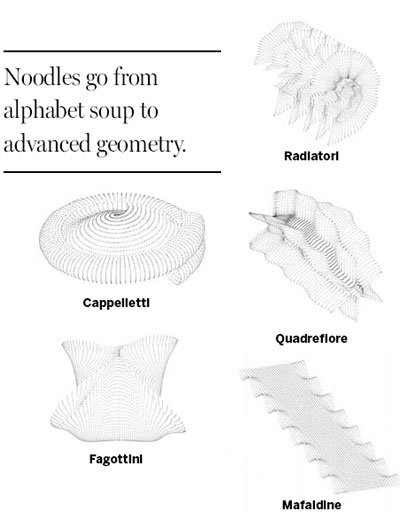Shapes of pasta as math equations
Updated: 2012-01-29 07:58
By Kenneth Chang(The New York Times)
|
|||||||
Eating pasta one day, Sander Huisman wondered what mathematical equation would describe the undulating shapes.
Mr. Huisman, a graduate student in physics at the University of Twente in the Netherlands, spends much of his days using Mathematica, software that solves complicated math problems and generates pretty pictures of the solutions. "I play around with Mathematica a lot," he said. "We were eating pasta, and I was wondering how easy these shapes would be recreated" with the software.
So Mr. Huisman figured out the five lines or so of Mathematica computer code that would generate the shape of the pasta he had been eating - gemelli, a helixlike twist - and a dozen others. "Most shapes are very easy to create indeed," he said.
He posted one to his blog, thinking he would do a sort of mathematical-pasta-of-the-month. But he then forgot about them until someone asked for the recipes of the other pasta shapes, and he posted those too.
Mr. Huisman, who studies fluid dynamics, is not the only one who has been mathematically inspired by pasta. Several years ago, Christopher Tiee, then a teaching assistant for a calculus class at the University of California, San Diego, gave a pop quiz asking students to match pasta shapes with the equations.
Meanwhile, in London, two architects, Marco Guarnieri and George L. Legendre, experienced a similar epiphany, also while eating pasta. Then Mr. Legendre turned the idea into a book, "Pasta by Design."
"We were interested in, if you like, the amalgamation of mathematics and cooking tips - the profane, the sacred," he said. "I was actually speaking to someone in Paris recently who said, 'This might have been a project by Dali.'"
The book classifies 92 types of pasta, organizing them into an evolutionlike family tree. For each, the book provides a mathematical equation, a mouthwatering picture of the pasta and suggested sauces to eat it with.
Mr. Legendre calls trenne, a pasta with the rigid angles of triangular tubes, a freak. "It's a mirror universe where everything is pliant and groovy, and in that universe there's someone that stands out, and it's the boring-looking trenne with its sharp edges," he said.
He has even designed a new shape - ioli, named for his daughter - which looks like a spiral wrapped around itself, a tubelike Mobius strip. He wants to manufacture about 45 kilograms of pasta ioli, but that is still probably months away, because of the challenges of connecting the ends together.
The New York Times

(China Daily 01/29/2012 page10)